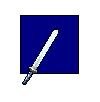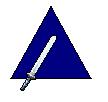Difference between revisions of "Fire Emblem Deck"
(Fixed the cards, though the layout is really messed up because the diamond cards are too tall.) |
(Updated for updated Infobox) |
||
| Line 4: | Line 4: | ||
| date = 21/12/2008 | | date = 21/12/2008 | ||
| players = 2 (2+ Untested) | | players = 2 (2+ Untested) | ||
| status = Playable | | status = | ||
| completion = Finished | |||
| playability = Playable | |||
| visuals = Graphical | |||
}} | }} | ||
Revision as of 07:06, 24 July 2010
| Fire Emblem | |
|---|---|
| Designer | Aetherknight |
| Date | 21/12/2008 |
| Players | 2 (2+ Untested) |
| This deck has not been categorised. | |
| To play Dvorak: Draw five cards each and leave the rest as a draw pile. On your turn, draw a card from the draw pile and play one Thing and/or one Action. (See the full rules.) | |
| This deck is locked. Further cards should not be added - leave feedback on the talk page. | |
Description:
Strike, calculate, parry and then go for the kill. A fighting game where the only hit that matter is the finishing blow. Inspired by the Fire Emblem's Weapon Triangle system and the epic Critical Hits.
Special Rules
To deal a mortal blow and eliminate a player the defending player must have 0 cards in play and the attacking player must have 0 cards in his hand.
Last one standing wins.
All cards are things that have 3 traits to them which come in different varieties Weapon: Sword, Axe, Lance Color: Red, Green, Blue Shape: Diamond, Square, Triangle, Circle
Weapon Triangle
Sword > Axe
Axe > Lance
Lance > Sword
So one would say an Axe card is weak to a Sword card while a Lance card is strong against a Sword card.
Game setup
Each player is dealt 7 cards (If more 2+ players it is suggested to print multiple copies of the deck to make a bigger deck) The person who is right of the dealer goes first and is dealt an additional card, 8 cards.
The top card of the deck is put into play as the starting Tempo card.
Tempo
The Tempo card is located in the center near the shared discard pile and deck and is not controlled by anyone but shared by all players. It determines what cards may be played.
Turn Structure
(Though all cards are things a player is still allowed actions described next)
1)Draw a card or draw until you have 5 cards.
2)Calculate
3)Parry
4)Strike (Play things)
5)Set the tempo
-)End turn
Strike
To strike your opponent you play an attack consisting of a 4 or more card combo where each card in the combo shares a trait.
(so all cards in the combo must have ex. Sword or Red or Triangle this is called its combo trait; but just because a card is Sword and red, another is Sword and blue and another is Axe and blue does not mean they can be played as a combo,)
Players may only strike with a combo whose trait matches a trait on the tempo card. If you are unable to make an attack skip your Set the tempo step.
Calculate
If you opponent has made an attack (if they have cards in play) Split 2 cards from a combo group and becomes its own group of 2, then draw a card. In order to deal with an attack you must anticipate it, the card draw represents a thought.
Parry
You may destroy a group consisting of 2 or less cards, then draw a card. You may parry an attack once it is obvious how to deal with it, raise your weapon to shunt it away or pushing your aggressor to keep your distance is represented by a card draw.
Set the tempo
After the exchange you are now in control and you set the tempo. Play a new tempo and destroy the old tempo. The new tempo card must be strong against the old tempo card and match one of its traits. (ex. Old Tempo: Blue Square Axe, acceptable New Tempo: Blue Diamond Sword, Red Square Sword, unacceptable New Tempo: Green Diamond Sword, Blue Square Lance, Green Diamond Axe)
If you cannot play an acceptable New Tempo then you truly do not have the upper hand and allow your opponent to make an attack unchecked.
If you cleared your mind and have laid it all on the line (no cards in hand) and your target is wide open (no cards in play) deliver the killing bow. Your victim has been killed in battle.



































